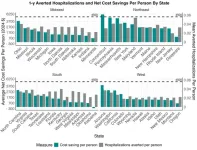(Press-News.org)
The COVID-19 pandemic had an unprecedented effect on college students’ mental health: symptoms like anxiety and major depression in young adults ages 18-25 increased significantly compared to before the pandemic.
A new study from researchers at the University of North Carolina at Chapel Hill looks at a possible contributing factor to the worsening trends in mental health: social media.
We know that college students and adolescents are using social media more. Last May, the US Surgeon General issued an advisory on social media and youth mental health, noting that there are “ample indicators” that social media can “pose a risk of harm to the mental health and well-being of children and adolescents.”
But questions remained: Are more depressed people using social media more? Or is social media contributing to more depression?
To answer this, a team led by economist Jane Cooley Fruehwirth used unique longitudinal survey data from first-year college students at a large public research university which was collected both before and during the pandemic. This data allowed them to compare social media usage before and during the pandemic along with other factors like social isolation, anxiety and depression symptoms, and how much students were sleeping, exercising, and interacting with their friends.
What they found was surprising: increased social media usage at the beginning of the pandemic didn’t have a large effect on college students’ mental health, but increased social media usage 18 months into the pandemic – when colleges had largely reopened and students were back on campus – did have a negative effect on students’ mental health. Students who increased their social media usage by an hour 18 months into the pandemic were much more likely to be depressed and anxious.
Why is this the case?
Fruehwirth and team found some evidence that social media use takes away from time for other activities that are good for mental health, such as exercise, when students were back in dorms, and that social media also seemed to increase stress from peers. Both early and later in the pandemic, the effects of social media usage were worst among socially isolated college students.
“These students who were socially isolated were not using social media to stay connected,” says Fruehwirth. “They were using it in a different way.”
Fruehwirth notes that resilience and social support helps protect students from the negative consequences of social media.
"This is not a "social media is bad" story,” she says. “It's that some students are using it in a way that isn't detrimental and some are, and we wanted to tease out those differences.”
The findings suggest that college campuses themselves can play a role in reducing isolation. Approximately 1 in 5 college students currently feels isolated on a college campus. This suggests that there’s more at play than just social media.
“Universities can think about how to build more connections through physical and social spaces, through connections through clubs,” says Fruehwirth. “They can create peer support networks and help build resilience.”
The study was published in Health Economics on June 14, 2024. Coauthors include Alex Xingbang Weng and Krista Perreira.
END
WASHINGTON, D.C., July 1, 2024 — The latest issues of four American Psychiatric Association journals, The American Journal of Psychiatry, Psychiatric Services, American Journal of Psychotherapy and Psychiatric Research and Clinical Practice are now available online.
The July issue of The American Journal of Psychiatry brings together research on affective disorders, pharmacogenomics, and psychiatric illness-related cardiometabolic problems. Highlights include:
• Genome-Wide Association Study of Treatment-Resistant Depression: Shared Biology With Metabolic Traits.
• Pharmacogenomic Clinical ...
The most climate-vulnerable countries with the highest hunger rates are significantly under-represented in agrifood research – sparking a need for urgent action and increased investments to redress this imbalance, a major new study has found.
The ‘State of the Field for Research on Agrifood Systems’ report, published by The Juno Evidence Alliance – a partnership of CABI, Havos.Ai and the University of Notre Dame, USA – found that only one out of eight research papers is led by scientists from ...
A team led by University of Maryland computer scientists invented a camera mechanism that improves how robots see and react to the world around them. Inspired by how the human eye works, their innovative camera system mimics the tiny involuntary movements used by the eye to maintain clear and stable vision over time. The team’s prototyping and testing of the camera—called the Artificial Microsaccade-Enhanced Event Camera (AMI-EV)—was detailed in a paper published in the journal Science Robotics in May 2024.
“Event cameras are a relatively new technology better at tracking ...
UNIVERSITY PARK, Pa. — To advance soft robotics, skin-integrated electronics and biomedical devices, researchers at Penn State have developed a 3D-printed material that is soft and stretchable — traits needed for matching the properties of tissues and organs — and that self-assembles. Their approach employs a process that eliminates many drawbacks of previous fabrication methods, such as less conductivity or device failure, the team said.
They published their results in Advanced Materials.
“People have been developing soft and stretchable conductors for almost a decade, but the conductivity ...
Waltham — July 1, 2024 — For patients with severe obesity undergoing knee or hip replacement, commonly obtained laboratory values – including markers of anemia and inflammation – are independent predictors of the risk of periprosthetic joint infection (PJI), reports a study in The Journal of Bone & Joint Surgery. The journal is published in the Lippincott portfolio by Wolters Kluwer.
Hemoglobin level, platelet count, and several markers of systemic inflammation may be relevant to the elevated ...
Chicago (July 1, 2024) — According to new research looking at every U.S. state, programs that deliver medically tailored meals (MTMs) to people with diet-sensitive conditions such as diabetes and heart disease along with limitations in the ability to perform daily activities could lead to substantial savings in healthcare costs. Using computer models to estimate the benefits of such programs minus the expense of implementing them, researchers found significant variation between U.S. states but an overall net cost savings in almost every state.
“By ...
When power plants burn fossil fuels at high temperatures, nitrogen and oxygen molecules break apart and then recombine to form a class of compounds called nitrogen oxides, or NOx. These gasses are major pollutants and contribute to—among other things—acid rain and global warming.
One way to curb such emissions is with a catalytic converter, similar to what’s used in a vehicle.
“The catalytic converter injects ammonia into the plant’s emissions stream, and the hydrogen in the ammonia reacts with the oxygen in the NOx, and the products ...
About The Study: In this phase 2 prospective validating paired cohort study, fluorine-18 PSMA-1007 PET/computed tomography was superior to magnetic resonance imaging (MRI) for the locoregional staging of prostate cancer. These findings support PSMA PET in the preoperative workflow of intermediate-risk and high-risk tumors.
Corresponding Author: To contact the corresponding author, Adam Kinnaird, M.D., Ph.D., email ask@ualberta.ca.
To access the embargoed study: Visit our For The Media website at ...
Hong Xue, Associate Professor, Health Administration and Policy, received funding for the project: “Innovating and Implementing Youth Tobacco Prevention in Virginia.”
Xue will leverage the forefront of technological innovation, utilizing generative artificial intelligence (AI) and state-of-the-art immersive technologies, integrating them with novel just-in-time adaptive intervention strategies, to tackle the pressing public health issue of electronic cigarette/tobacco use among the youth in Virginia.
Xue will receive $450,000 from Virginia ...
Emanuel Petricoin, Co-Director, Center for Applied Proteomics and Molecular Medicine (CAPMM), received funding for the project: “Protein Pathway Activation Based Signaling Mapping of Head And Neck Cancers.”
CAPMM researchers will receive laser microdissected tumor samples from banked Formalin-Fixed Paraffin-Embedded (FFPE) clinical biopsy samples from patients with HPV‐positive head and neck cancers who were treated for newly diagnosed disease.
The researchers will utilize comprehensive reverse‐phase ...




